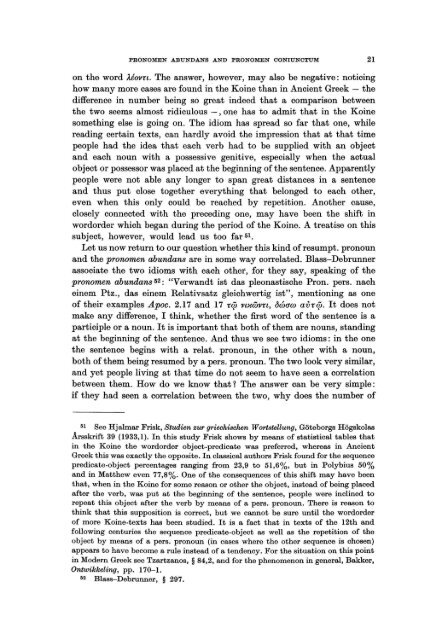Pronomen Abundans and Pronomen Coniunctum. A ... - DWC
Pronomen Abundans and Pronomen Coniunctum. A ... - DWC
Pronomen Abundans and Pronomen Coniunctum. A ... - DWC
You also want an ePaper? Increase the reach of your titles
YUMPU automatically turns print PDFs into web optimized ePapers that Google loves.
PRONOMEN ABUNDANS AND PRONOMEN CONIUNCTUM 21<br />
on the word À.éOVTt. The answer, however, mayalso be negative: noticing<br />
how many more cases are found in the Koine than in Ancient Greek - the<br />
difference in number being so great indeed that a comparison between<br />
the two seems almost ridiculous -, one has to admit that in the Koine<br />
something else is going on. The idiom has spread so far that one, while<br />
reading certain texts, can hardly avoid the impression that at that time<br />
people had the idea that each verb had to be supplied with an object<br />
<strong>and</strong> each noun with a possessive genitive, especially when the actual<br />
object or possessor was placed at the beginning ofthe sentence. Apparently<br />
people were not able any longer to span great distances in a sentence<br />
<strong>and</strong> thus put close together everything that belonged to each other,<br />
even when this only could be reached by repetition. Another cause,<br />
closely connected with the preceding one, may have been the shift in<br />
wordorder which began during the period of the Koine. A treatise on this<br />
subject, however, would lead us too far 51.<br />
Let us now return to our question whether this kind ofresumpt. pronoun<br />
<strong>and</strong> the pronomen alJundans are in some way correlated. Blass-Debrunner<br />
associate the two idioms with each other, for they say, speaking of the<br />
pronomen abundans 52 : "Verw<strong>and</strong>t ist das pleonastische Pron. pers. nach<br />
einem Ptz., das einem Relativsatz gleichwertig ist", mentioning as one<br />
of their examples Apoc. 2.17 <strong>and</strong> 17 up Vl"WVTt, M)(J()) avnp. It does not<br />
make any difference, I think, whether the first word of the sentence is a<br />
participle or a noun. It is important that both of them are nouns, st<strong>and</strong>ing<br />
at the beginning of the sentence. And thus we see two idioms: in the one<br />
the senten ce begins with arelat. pronoun, in the other with a noun,<br />
both of them being resumed by a pers. pronoun. The two look very similar,<br />
<strong>and</strong> yet people living at that time do not seem to have seen a correlation<br />
between them. How do we know that? The answer can be very simpie:<br />
if they had seen a correlation between the two, why does the number of<br />
51 See Hjalmar Frisk, Studien zur griechischen Wortstellung, Göteborgs Högskolas<br />
Ársskrift 39 (1933,1). In this study Frisk shows by means of statistical tables that<br />
in the Koine the wordorder object.predicate was preferred, whereas in Ancient<br />
Greek this was exactly the opposite. In classical authors Frisk found for the sequence<br />
predicate-object percentages ranging from 23,9 to 51,6%, but in Polybius 50%<br />
<strong>and</strong> in Matthew even 77,8%. One of the consequences of th is shift may have been<br />
that, when in the Koine for some reason or other the object, instead of being placed<br />
af ter the verb, was put at the beginning of the sentence, people were inclined to<br />
repeat this object af ter the verb by means of a pers. pronoun. There is reason to<br />
think that this supposition is correct, but we cannot be sure until the wordorder<br />
of more Koine-texts has been studied. It is a fact that in texts of the 12th <strong>and</strong><br />
following centuries the sequence predicate-object as weIl as the repetition of the<br />
object by means of a pers. pronoun (in cases where the other sequence is chosen)<br />
appears to have become a rule instead of a tendency. For the situation on this point<br />
in Modern Greek see Tzartzanos, § 84,2, <strong>and</strong> for the phenomenon in general, Bakker,<br />
Ontwikkeling, pp. 170-1.<br />
52 Blass-Debrunner, § 297.
















